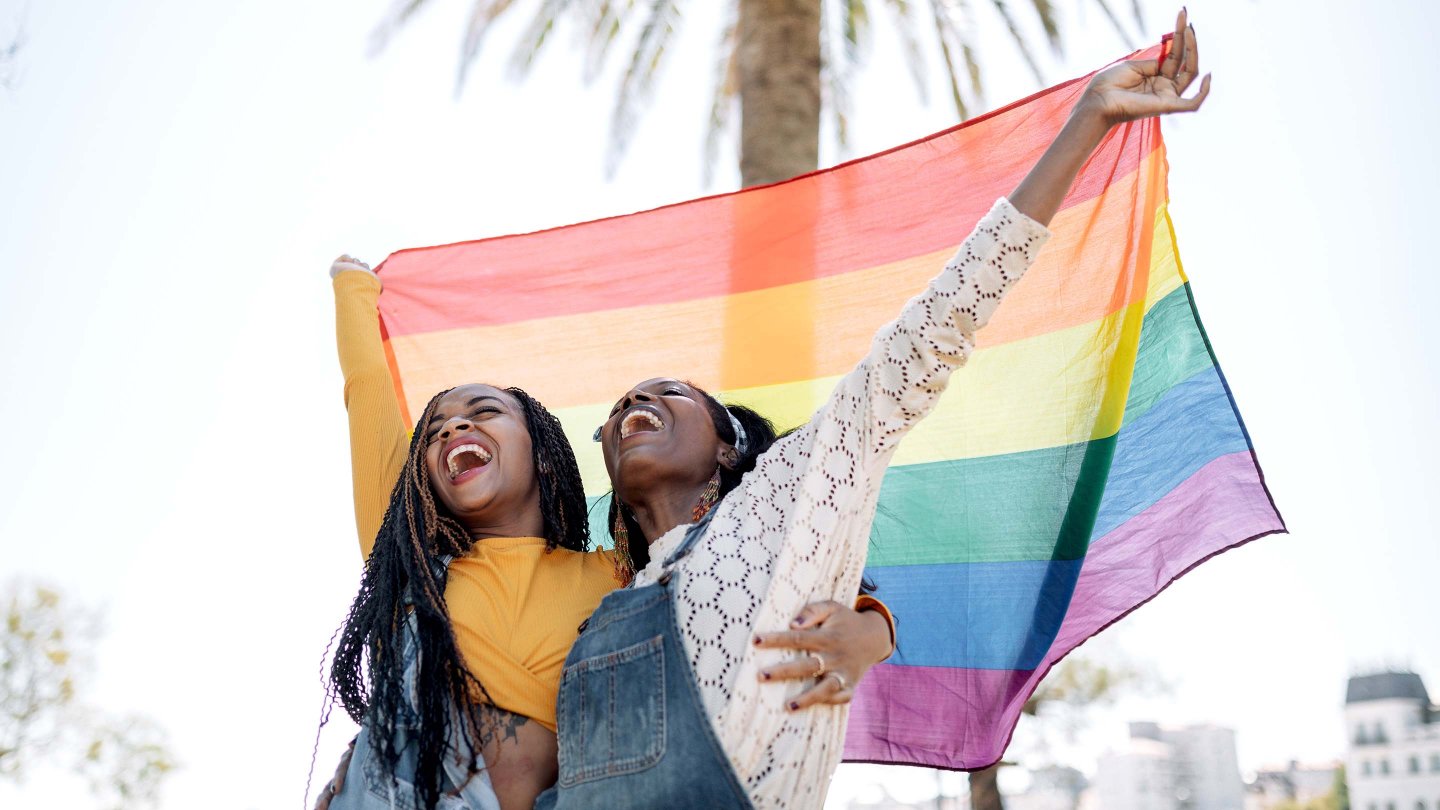Pride 2022: Small actions to make a big difference
 Low angle of delighted African American females in love hugging on street while standing with LGBT rainbow flag and looking away
Low angle of delighted African American females in love hugging on street while standing with LGBT rainbow flag and looking away
Pride 2022: Small actions make a big difference for LGBTQ+ colleagues
Pride Month is a time to celebrate our LGBTQ+ colleagues at work — but it’s also a time to take tangible actions to support and advocate for them all year long.
Research from our Mercer Marsh Benefits Health on Demand Report has found that employees who identify as LGBTQ+ are significantly more likely to experience anxiety and depression due to extrinsic factors, such as long-term exposure to discrimination or “microaggressions” — subtle comments or actions that express hostility or negativity, whether consciously or not, toward members of a marginalized group.
This year’s Pride month comes during a particularly stressful time. The ongoing pandemic has posed significant challenges to LGBTQ+ colleagues in terms of mental health stressors and access to care and resources.
of LGBTQ+ employees say the COVID-19 pandemic has had a negative impact on their lives
of LGBTQ+ employees report feeling "extremely" or "highly" stressed
We’ve previously offered four suggestions for how employers can play a role in supporting LGBTQ+ employees in the workplace: listening, providing inclusive benefits, highlighting learning and allyship, and holding leaders accountable for DEI goals.
Indeed, many organizations have done well in addressing systemic bias against LGBTQ+ employees — helping all employees understand the importance of avoiding harassment, discrimination or overt aggression at work.
But eradicating hostility is not the same as inviting true inclusion and belonging — and empowering all colleagues to be themselves, no matter their gender identities.
The day-to-day experience of inclusion and belonging is mostly driven by interactions with colleagues and peers. Many employees commit microaggressions without even realizing they’re doing so.
Organizations must set expectations and educate employees on how to practice inclusive behaviour every day and make it the norm.
Here are seven practices to encourage in your organization:
-
Show up as an allyIt’s important for employees to spend time and energy supporting their words with actions. Encourage employees to attend events sponsored by LGBTQ+ BRGs and ERGs and to engage with articles or posts on these topics on your internal networks.
-
Normalize sharing pronounsOne very simple way of levelling the social playing field for nonbinary and trans employees is to normalize the use of pronoun sharing. Encourage employees to add pronouns to email signature lines, and routinely include them in verbal introductions, Zoom names, bios/profiles and nametags. Encourage employees also to be mindful of using the correct pronouns once they have been introduced.
-
Learn the vocabulary of inclusionIn addition to pronouns, help employees become familiar with inclusive LGBTQ+ vocabulary and become comfortable using it when appropriate. Becoming comfortable with important terms — such as gender identity or heteronormativity — can open new avenues of understanding for non-LGBTQ+ employees and go a long way toward helping LGBTQ+ colleagues feel understood and accepted.
-
Use language thoughtfully and inclusivelyAsk employees to think about the language they use every day — which they may not even be aware carries bias. Inclusive language entails positive word choices that respect and acknowledge the broad diversity of people in the workplace, including their genders, sexuality and relationships. One example might be avoiding binary-assumptive language, such as “ladies and gentlemen,” or gender-assumptive words, such as “guys.” Instead, use more inclusive terms, like “folks.”
-
Recognize the diversity of familiesCaution employees not to make assumptions about what someone’s family or personal life might look like — assumptions that could make LGBTQ+ employees feel isolated or less comfortable participating fully in conversations and activities. Questions such as “what does your husband or wife do?” might put an employee in an awkward position. Employees should be encouraged to invite conversation that brings the whole self to work, but it should be done in an open-ended way that lets others identify parts of their own stories rather than identifying them in error. “Tell me all about yourself” is a good example of an inclusive conversation starter.
-
Let LGBTQ+ colleagues set their own boundariesSome employees will welcome the opportunity to share more about their lives with work colleagues. Others will wish to remain more private or reserved. Be sure employees allow LGBTQ+ employees to set those boundaries on their own. Help them create a safe space for sharing, but don’t push employees or put them on the spot to share more than they’re comfortable with.
-
Support colleagues who are transitioningEmployees should be encouraged to give full support to colleagues who are transitioning or who have family members who are non-gender-conforming. People need to understand the harmful effects of insisting there are only two genders, for example, or that gender and sexual identities are choices. This can be particularly challenging for employees who are still struggling to accept transgender identities, so it’s crucial to teach employees how they can be respectful of transitions regardless of their own perspectives on the issues.
To truly make a difference for the LGBTQ+ community, create resources and model behaviour that lasts all year long instead of limiting efforts to Pride Month. This will help send the message that inclusion and belonging are core facets of your organizational culture that should be cultivated every day.
Even in these few simple actions, there’s a tremendous and exciting opportunity to make a big difference in how inclusive your work culture is and to support the LGBTQ+ community through everyday habits. When we show up more broadly in support of our LGBTQ+ coworkers — whether they’re present or not — we increase the visibility of inclusive behaviour and help model an inclusive environment to all colleagues.
Pride 2022: You are welcome here
As we think about Pride and what it means to us at Mercer, we’re celebrating our vibrant LGBTQ+ community – and empowering all colleagues to be themselves.
Related solutions
-
Attract & retain talentMercer’s strategic workforce planning solutions provide a rational business basis to prioritize, develop and fund the people practices needed to support business…
-
Total rewards
Pay equity analysis and remediation
Gender and racial pay equity has become a critical priority for C-suite and HR leaders. We help organizations effectively address pay equity and ensure fairness in… -
Industries
Mercer works with companies in the energy, technology, retail, healthcare, automotive, and financial services & insurance industries to address strategic…
Related insights
-
Mitigating climate health risks through innovation at Davos 2025
Mitigating climate health risks through innovation at Davos 2025. The World Economic Forum fosters collective leadership and local strategies for solutions. -
Benefit strategies
Top health trends for 2025
Top healthcare research trends shaping the future of employer-sponsored benefits may sound familiar, but a lot is changing. Find out the top 3 trends and actions… -
Benefit strategies
Understand and support women's unique health and wealth concerns
Address women's unique health and wealth concerns by creating tailored benefits strategies that support their mental, reproductive, and financial wellness.






